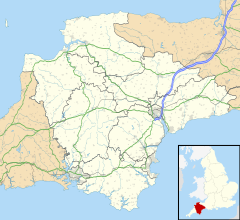Yelland is a village of 2,000 inhabitants situated in North Devon between Instow and Fremington in the English county of Devon. Yelland is included within the parish of Fremington.
| Yelland | |
|---|---|
Location within Devon | |
| Population | 2,000 |
| Civil parish | |
| District | |
| Shire county | |
| Region | |
| Country | England |
| Sovereign state | United Kingdom |
| Police | Devon and Cornwall |
| Fire | Devon and Somerset |
| Ambulance | South Western |
| UK Parliament | |
Amenities
editThere is a garage, and a small industrial park. Residents use the nearest major village Fremington, or the slightly smaller village of Instow for their daily needs. Supermarkets are located in the nearest towns - Barnstaple and Bideford. There is no church situated in the village.
Regular bus services are operated by Stagecoach Devon. The nearest railway station is Barnstaple railway station, and Exeter International Airport is the nearest passenger international airport by road. The nearest international ferry port is at Plymouth.
Children in the area generally attend Fremington or Instow Primary Schools at primary school age, and Bideford College, Pilton Community College or The Park Community School at secondary school age. College students attend Bideford College's sixth form, Petroc (formerly North Devon College), or may travel further afield.
Archaeology
editNear Lower Yelland Farm is a Bronze Age megalithic site consisting of a double stone row. They are unusual in being sited at the river's edge rather than on higher moorland. Since its construction, thousands of years ago, the site has been smothered by silt from the widening of the River Taw. The stones are no longer visible.
Walking trails
editVisitors to Yelland and the surrounding area enjoy the views and scenic paths for walking. The Tarka Trail and South West Coast Path are easily accessible from the Yelland Power Station Road. Also Lower Yelland Nature Reserve.
East Yelland Coal-fired Power Station
editThe East Yelland Power Station was once an operational coal-fired electricity production plant located in a partially hidden area on the estuary, next to the Tarka Trail. The power station was one of only two located to the west of Hinkley Point.
The power station was sanctioned in September 1949, and an extension approved in June 1950. The first generating set was commissioned in July 1953 and subsequent sets in November 1953, September 1954, October 1956, December 1956, and October 1957.[1] The power station was formally opened on 21 April 1955[2] by Lord Fortescue. The station had a net capability to deliver 170 MW of electricity from six Parsons 31 MW turbo-alternators. There was also a 225 kW diesel engine house service set. The Thompson radiant heat steam boilers were fired by twin chain grate stokers could deliver 253 kg/s of steam at 42.7 bar and 468 °C. Cooling water to condense steam in the plant was drawn from the river estuary. The generating capacity and output was:[3][4][1][5][6]
Graphs are unavailable due to technical issues. There is more info on Phabricator and on MediaWiki.org. |
| Year | 1954 | 1955 | 1956 | 1957 | 1958 | 1961 | 1962 | 1963 | 1967 | 1972 | 1979 | 1981 | 1982 |
|---|---|---|---|---|---|---|---|---|---|---|---|---|---|
| Capacity MW | 56 | 85 | 85 | 143 | 176 | 186 | 204 | 204 | 204 | 194 | 180 | 180 | 170 |
| Output GWh | 128.47 | 361.57 | 392.61 | 511.57 | 653.86 | 498 | 541.3 | 658.7 | 761.46 | 510.76 | 74.8 | 3.1 | 14.54 |
In the year ending 31 March 1981 the station delivered just 0.2 per cent of its capability.[4] In March 1984, it was announced by the Central Electricity Generating Board that the power station would close by the end of October that year.[2]
Fuel for the power station was obtained from coal mines in South Wales, and was transported across the Bristol Channel onto a jetty specially constructed for the power station. However, due to the closure of the coal mines in the 1980s, coal would be more expensive to obtain from other areas of the country. Therefore, it was more economical to close the power station.
Today, most of the power station, which covered an area of 3.1ha, has been demolished.
References
edit- ^ a b Garrett, Frederick C., ed. (1959). Garcke's Manual of Electricity Supply vol.56. London: Electrical Press. pp. A-53, A-120.
- ^ a b "South Western Electricity Board Chronology 1948 – 1990". South Western Electricity Historical Society. Archived from the original on 13 December 2007.
- ^ CEGB (1972). CEGB Statistical Yearbook 1972. London: CEGB. p. 11.
- ^ a b CEGB Statistical Yearbook operating results 1980-81. 1981, CEGB, London.
- ^ CEGB (1982). CEGB Statistical Yearbook 1981-2. CEGB. ISBN 0902543695.
- ^ CEGB Annual Report and Accounts, 1961, 1962 & 1963
External links
edit- Information about the Megalithic site including photos and an aerial photo showing its location, at megalithic.co.uk
